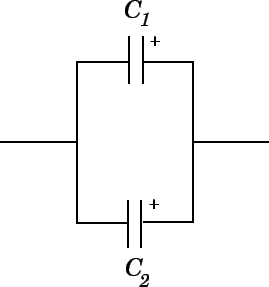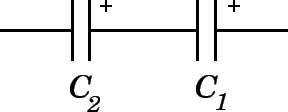


Next: Energy Stored by Capacitors
Up: Capacitance
Previous: Dielectrics
Capacitors are one of the standard components in electronic circuits.
Moreover, complicated combinations of capacitors often occur
in practical circuits. It is,
therefore, useful to have a set of rules for finding the equivalent capacitance
of some general arrangement of capacitors. It turns out that we can always find the
equivalent capacitance by repeated
application of two simple rules. These rules related to capacitors connected
in series and in parallel.
Figure 15:
Two capacitors connected in parallel.
 |
Consider two capacitors connected in parallel: i.e., with the
positively charged plates connected to a common ``input'' wire, and the negatively
charged plates attached to a common ``output'' wire--see Fig. 15. What is the equivalent capacitance
between the input and output wires? In this case, the potential
difference  across the two capacitors is the same, and is equal to
the potential difference between the input and output wires. The total charge
across the two capacitors is the same, and is equal to
the potential difference between the input and output wires. The total charge
 , however, stored in the two capacitors is divided between the
capacitors, since it must distribute itself such that the voltage across the
two is the same. Since the capacitors may have different capacitances,
, however, stored in the two capacitors is divided between the
capacitors, since it must distribute itself such that the voltage across the
two is the same. Since the capacitors may have different capacitances,  and
and  ,
the charges
,
the charges  and
and  may also be different. The equivalent capacitance
may also be different. The equivalent capacitance
 of the pair of capacitors is simply the ratio
of the pair of capacitors is simply the ratio  , where
, where
 is the total stored charge. It follows that
is the total stored charge. It follows that
 |
(113) |
giving
 |
(114) |
Here, we have made use of the fact that the voltage  is common to all three
capacitors. Thus, the rule is:
is common to all three
capacitors. Thus, the rule is:
The equivalent capacitance of two capacitors connected in parallel
is the sum of the individual capacitances.
For  capacitors connected in parallel, Eq. (114) generalizes to
capacitors connected in parallel, Eq. (114) generalizes to
 .
.
Figure 16:
Two capacitors connected in series.
 |
Consider two capacitors connected in series: i.e., in a line such that
the positive plate of one is attached to the negative plate of the other--see
Fig. 16.
In fact, let us suppose that the positive plate of capacitor 1 is connected
to the ``input'' wire, the negative plate of capacitor 1 is connected to
the positive plate of capacitor 2, and the negative plate of capacitor
2 is connected to the ``output'' wire.
What is the equivalent capacitance between the input and output wires?
In this case, it is important to realize that the charge  stored in
the two capacitors is the same. This is most easily seen by considering
the ``internal'' plates: i.e., the negative plate of capacitor 1, and
the positive plate of capacitor 2. These plates are physically disconnected
from the rest of the circuit, so the total charge on them must
remain constant. Assuming, as seems reasonable, that these plates carry zero charge
when zero potential difference is applied across the two capacitors, it follows
that in the presence of a non-zero potential difference the charge
stored in
the two capacitors is the same. This is most easily seen by considering
the ``internal'' plates: i.e., the negative plate of capacitor 1, and
the positive plate of capacitor 2. These plates are physically disconnected
from the rest of the circuit, so the total charge on them must
remain constant. Assuming, as seems reasonable, that these plates carry zero charge
when zero potential difference is applied across the two capacitors, it follows
that in the presence of a non-zero potential difference the charge  on the positive
plate of capacitor 2 must be balanced by an equal and opposite charge
on the positive
plate of capacitor 2 must be balanced by an equal and opposite charge
 on the negative plate of capacitor 1. Since the negative plate of
capacitor 1 carries a charge
on the negative plate of capacitor 1. Since the negative plate of
capacitor 1 carries a charge  , the positive plate must carry a charge
, the positive plate must carry a charge  .
Likewise, since the positive plate of capacitor 2 carries a charge
.
Likewise, since the positive plate of capacitor 2 carries a charge  , the
negative plate must carry a charge
, the
negative plate must carry a charge  . The net result is that both capacitors
possess the same stored charge
. The net result is that both capacitors
possess the same stored charge  . The potential drops,
. The potential drops,  and
and  , across
the two capacitors are, in general, different. However, the sum of these
drops equals the total potential drop
, across
the two capacitors are, in general, different. However, the sum of these
drops equals the total potential drop  applied across the input and output
wires: i.e.,
applied across the input and output
wires: i.e.,  . The equivalent capacitance of the pair of
capacitors is again
. The equivalent capacitance of the pair of
capacitors is again
 .
Thus,
.
Thus,
 |
(115) |
giving
 |
(116) |
Here, we have made use of the fact that the charge  is common to all three
capacitors.
Hence, the rule is:
is common to all three
capacitors.
Hence, the rule is:
The reciprocal of the equivalent capacitance of two capacitors connected in
series is the sum of the reciprocals of the individual capacitances.
For  capacitors connected in series, Eq. (116) generalizes to
capacitors connected in series, Eq. (116) generalizes to




Next: Energy Stored by Capacitors
Up: Capacitance
Previous: Dielectrics
Richard Fitzpatrick
2007-07-14

